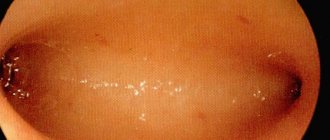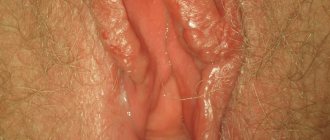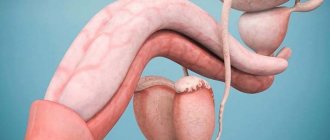The cause of inflammation can be sexually transmitted pathogens. Most often these are chlamydia and gonococci. If these bacteria enter the female genital tract as a result of infection, then the acidic environment of the vagina is not suitable for them, and they strive with all their might to get into the pipes, where the environment is more suitable. In addition, there is a cylindrical epithelium in which chlamydia can live. These pathogenic bacteria are “armed” with a sufficient arsenal of means to resist the immune system. However, inflammation in the appendages can be caused not only by the listed microorganisms.
Inflammation of the ovarian appendages is accompanied by nagging pain in the iliac region, which can even be confused with appendicitis. Fever and weakness are often noted. Pain occurs or intensifies during menstruation.
Complications
- Infertility.
It occurs due to the fact that during the inflammation the epithelial cells of the fallopian tubes are also affected. As a result, their normal function is disrupted, and the outcome may be scarring of the tube, which completely stops its functioning. During prolonged inflammation of the ovarian capsule, connective tissue grows. The ovarian capsule thickens and becomes denser. And it may happen that it becomes too strong and does not rupture at the moment of ovulation of the follicle. A mature egg will not be able to leave the follicle and will remain “imprisoned.” In this case, pregnancy will also be impossible. In addition to the tube and ovary, the adjacent peritoneum, the inner lining of the abdominal cavity, is affected. To limit the spread of infection in the peritoneum, connective tissue grows and adhesions are formed that glue the layers of the peritoneum together, limiting inflammation, but at the same time leading to immobility of the internal organs. This includes a decrease in the mobility of the fallopian tubes, which is necessary for the complete transfer of the egg to the uterus. The functioning of the fallopian tubes and ovaries is especially severely disrupted if the process has a long, chronic course. And acute inflammation almost always leads to it if left untreated. Therefore, when signs of inflammation of the appendages appear, you cannot expect that everything will go away by itself. In addition to infertility, inflammation of the appendages is fraught with serious complications, for example, a purulent abscess, which threatens peritonitis.
- Pyovar
is an extensive suppuration of the ovaries, up to their transformation into ulcers, due to the development of the inflammatory process in the pelvic organs. Pyovar occurs when the inflammatory process tends to suppurate. The course of the disease is characterized by duration and is accompanied by frequent exacerbations. For acute cases, the following symptoms are typical: sharp pain, high fever and leucorrhoea. In chronic cases, leucorrhoea becomes purulent, the patient notes painful sensations in the groin, which noticeably intensify during menstruation. These pains radiate to the thigh and sacrum. They become sharp during physical activity, sexual intercourse, and bowel movements.
- Sactosalpinx
is an accumulation of fluid in the lumen of the fallopian tube with the formation of a saccular formation. It is formed as a result of “soldering” of the pipe, most often during a subacute ongoing inflammatory process. The contents may be serous, serous-hemorrhagic. When suppuration occurs from the sactosalpinx, pyosalpinx develops. Salpingitis is an inflammation of the fallopian tubes, salpingoophoritis is a general inflammation of the tubes and ovaries, and pyosalpinx is the accumulation of pus in the tubes and their adhesion to the ovary when the infection and purulent inflammatory process spreads towards the peritoneum. Most often, both the fallopian tubes and the ovaries are simultaneously involved in the process (due to the proximity of the anatomical location) with the development of salpingoophoritis - a general inflammation of the fallopian tubes and ovaries (uterine appendages).
- With further development of the purulent process, salpingo-oophoritis can lead to the development of tubovarial formation and abscess, the rupture of which causes peritonitis.
Complications of PID
Diseases of the pelvic organs are very insidious, as they can cause serious complications, such as:
- ectopic pregnancy (can occur in every sixth woman with PID);
- chronic pelvic pain (one in five women with pelvic inflammatory disease suffers from it);
- tubal infertility (diagnosed in every fourth patient);
- ovarian dysfunction.
Also, with PID, inflammation of the pelvic peritoneum (pelvioperitonitis) is possible, which often develops into sepsis, tubo-ovarian abscess, which can be fatal.
Treatment
Depends on the stage of the disease and the severity of the process. In the subacute and chronic stages - physiotherapy. In case of an acute process - treatment in a hospital.
Conservative treatment includes rest, regimen, and antibacterial drugs (selected individually, taking into account the sensitivity of the patient’s flora).
Laparoscopy has proven itself well for therapeutic purposes: it allows you to eliminate the purulent focus in a gentle way, wash and drain the abdominal cavity, and remove the effects of chronic inflammation. In addition, in case of salpingo-oophoritis, the gynecological department of our center performs local injection of antibiotics into the ligaments next to the tube (during laparoscopy), which shortens the duration of the disease, quickly improves the patient’s condition, and reduces rehabilitation time.
Thus, diagnosis and appropriate treatment tactics, including the extent of the upcoming operation, in patients with purulent inflammatory diseases of the internal genital organs are determined individually, based on the results of clinical diagnostic studies, and are directly dependent on the nature of the identified changes.
It should be emphasized that for patients with severe purulent inflammatory diseases of the internal genital organs, surgical treatment is vital. The scope of operations varies from conservative-saving methods of laparoscopy and laparotomy to radical ones in the most severe cases.
The most common female diseases: symptoms and treatment
Women's health is an important and sensitive topic. Any disease causes discomfort, disrupts the quality of life, and can lead to serious consequences. The situation is complicated by the fact that discussing intimate problems with someone is not always possible. Even when visiting a doctor, women often feel awkward describing their symptoms.
Meanwhile, there is no need to be shy about issues related to the health of the reproductive organs. Most diseases that can cause infertility, the growth of malignant cells and other serious pathologies are easily treated in the early stages. At the first signs of illness, you should consult a doctor. The specialist will make a diagnosis and prescribe appropriate treatment.
Causes of development of female diseases
There are external and internal provoking factors.
External causes of disease development:
- unfavorable ecological environment;
- neuroses, psychological stress, chronic stress and frequent depression;
- promiscuity;
- mechanical injuries of the external and internal genital organs;
- viral and bacterial infections, including STIs;
- early onset of sexual activity;
- incorrect choice of underwear;
- insufficient hygiene of intimate areas;
- local allergic reaction to fabrics, cosmetics;
- frequent and incorrect use of medications, especially oral contraceptives and antibiotics.
Internal provoking factors:
- inflammatory processes in the body that are a source of infection: chronic tonsillitis, sinusitis, pyelonephritis, etc.;
- hormonal imbalance due to gynecological, endocrine diseases;
- anomalies of the anatomical structure of internal organs;
- frequent miscarriages, abortions;
- the presence of systemic diseases (for example, diabetes).
Types of female diseases
According to the etiology of the disease there are:
- Inflammatory. Pathology is caused by the activity of microorganisms: viruses, bacteria, fungi. Diseases such as endometritis, mastitis, colpitis, and thrush are manifested by inflammation.
- Hormonal. Pathologies develop against the background of a hormone imbalance caused by disruption of the glands. This group of diseases is characterized by severe and multiple symptoms. Hormonal changes cause uterine fibroids, endometriosis, menstrual irregularities, and provoke the development of conditional pathologies such as multifollicular ovaries.
- Hyperplastic. The cause of the disease is the growth of a tumor. The tumor can be benign or oncological in nature. Hyperplastic diseases include cervical erosion, cysts, breast cancer, etc.
Let's look at the most common female diseases.
Inflammation of the uterine appendages
The disease develops when pathogens (gonococcus, streptococcus) or conditionally pathogenic microbes enter the body against the background of decreased immunity. Inflammation of the uterine appendages is often diagnosed after hypothermia, installation of an intrauterine device, or artificial termination of pregnancy.
Main symptoms:
- pain in the lower back and lower abdomen from the inflamed organ, which can radiate to the sacrum or anus;
- copious discharge with an unusual odor;
- weakness due to general intoxication;
- elevated body temperature.
Inflammation can spread to the ovaries and fallopian tubes, become chronic, which is more difficult to treat, and affect one or both uterine appendages. If left untreated, complications arise. According to medical statistics, about 20% of women suffering from infertility previously had inflammation of the uterine appendages and were not treated in a timely manner. The pathology also increases the risk of ectopic pregnancy. In advanced cases, purulent processes develop in the internal genital organs.
For diagnosis, an examination by a gynecologist is sufficient.
Uterine fibroids
Myoma is formed from muscle cells and is a benign tumor. The neoplasm does not degenerate, but increases in size. The growth of uterine fibroids causes discomfort and creates the risk of bleeding. During menopause, due to a decrease in the level of female sex hormones, the formation may decrease in size.
Causes of uterine fibroids:
- hormonal imbalance with an increase in the level of estrogen and progesterone in the blood;
- frequent abortions, curettage of the uterine cavity;
- irregular sex life;
- passive lifestyle.
Myoma has no characteristic symptoms. A woman learns about the presence of a neoplasm during a routine examination by a gynecologist or an ultrasound scan. In rare cases, bleeding that is not associated with menstruation is observed. A large tumor makes it difficult to urinate.
Endometriosis
The endometrium is the inner layer of cells lining the uterus. The peculiarity of the tissue is its ability to respond to changes in hormonal levels during the cycle. During the period of ovulation, when the uterus is preparing for fertilization, the endometrium thickens, grows, and a branched network of blood vessels is formed. If conception does not occur, the cells gradually exfoliate and menstruation begins.
Endometriosis is a pathology that is manifested by abnormal growth of the endometrium outside the uterine cavity. The disease has many causes: hormonal disorders, decreased protective function of the body, hereditary predisposition, etc. Endometriosis of the uterine appendages is accompanied by an enlargement of these organs.
There are no characteristic symptoms of pathology. Tissue proliferation does not manifest itself in any way in the initial stages. As the disease progresses, the following signs appear:
- heavy and painful menstruation;
- cycle disorders;
- weakness, general malaise;
- periodic lower back pain;
- spontaneous bleeding not associated with the menstrual cycle.
Mild forms of endometriosis are treated with conservative methods. In severe cases, laparoscopy is performed.
Cervical erosion
Disorders of the cervical mucosa are often diagnosed in women of reproductive age. The disease itself is not life-threatening, but it must be treated to prevent complications. Cervical erosion develops against the background of hormonal disorders, decreased immunity, inflammation, and endocrine diseases. To diagnose and exclude malignant processes, colposcopy is indicated.
Symptoms of pathology:
- pain during sexual intercourse;
- itching and discharge when infection occurs.
Signs of the disease rarely appear. Usually a woman learns about erosion at an appointment with a gynecologist. There are many modern treatment methods that completely eliminate the pathology without damaging or injuring the cervix.
Colpitis
An inflammatory disease localized in the vagina. Colpitis can be caused by any infectious agent: bacteria, virus, fungus. The disease is more often diagnosed in young women who are sexually active.
Symptoms of colpitis:
- pain in the lower abdomen;
- copious discharge that causes itching and burning of the external genitalia;
- rash on the skin of the perineum;
- dysuria (painful urination, frequent urge);
- swelling of the external genitalia.
The disease in its acute form has pronounced symptoms, the quality of life decreases, and the woman feels constant discomfort.
Chronic colpitis is less pronounced. The only symptoms that may be present are discharge and itching. Periods of exacerbation are followed by remissions.
Thrush
An inflammatory disease caused by the growth of the fungus Candida. These microorganisms are present in the microflora of every person, but do not manifest themselves in any way. In order for the fungus to begin to actively grow and cause disease, provoking factors are needed. The aggressiveness of the pathogen can be provoked by long-term use of antibiotics, decreased local immunity, poor hygiene of intimate areas, hormonal imbalances and other reasons.
According to statistics, about 75% of women have experienced symptoms of candidiasis at least once in their lives:
- leucorrhoea of a cheesy nature with a sour odor;
- burning sensation in the perineum after sexual intercourse;
- soreness, itching in the vagina.
Thrush can occur with acute manifestations or be chronic.
Polycystic ovary syndrome (PCOS) and multifollicular ovaries
The disease is more often diagnosed in women aged 25–30 years. The prevalence of pathology is 2.5–8%.
The phenomenon of multifollicular ovaries itself is not a pathology. However, the process of follicle maturation and ovulation is disrupted. Gradually, the ovary becomes covered with multiple formations (non-ovulated follicles) - polycystic disease is formed. Among the causes of the disease are a genetic predisposition to increased levels of androgens and obesity.
Symptoms of PCOS:
- painful menstruation;
- the appearance of acne on the face;
- fluctuations in blood pressure both up and down;
- depressed state, depression;
- alopecia of certain areas or, conversely, excess hair growth (for example, mustache);
- skin pigmentation.
The most characteristic symptom of polycystic disease is irregular menstruation. The duration of the cycle can be several months.
Menstrual irregularities
Failure to menstruate is not a disease - it is a symptom of other pathologies. Normally, menstruation lasts from 3 to 8 days and repeats every 3-5 weeks. A cycle that is too long or too short, heavy or scanty discharge should be considered a symptom of the disease. A doctor's consultation is required. The absence of menstruation during childbearing age is a serious pathology.
The causes of menstrual irregularities are various:
- thyroid diseases, diabetes mellitus;
- hormonal disorders due to dysfunction of the ovaries and pituitary gland;
- chronic fatigue, stress;
- gynecological diseases with acute or chronic course;
- unfavorable ecological environment;
- irregular and/or unhealthy diet;
- malignant neoplasms.
To find and eliminate the cause of menstrual irregularities, a woman is prescribed a comprehensive laboratory and instrumental examination.
Mastitis
The disease develops in the mammary gland. Mastitis is an inflammation of the ducts or functional tissues of the breast. More often, the pathology is diagnosed in nursing women. The vast majority of cases occur in first-time mothers.
The main reason for the development of mastitis is stagnation of breast milk. Liquid is an ideal breeding ground for bacteria. The development of infection causes characteristic symptoms:
- feeling of fullness, tightness, pain in the mammary gland;
- redness and swelling of the skin on the side of inflammation;
- increase in body temperature.
Lack of treatment threatens the appearance of an abscess and sepsis. Timely consultation with a doctor allows you to quickly and completely get rid of mastitis.
Mammary cancer
Cancer is a malignant tumor. In different regions of the world, the prevalence of the disease ranges from 10 to 30%. Breast cancer affects women of all ages, including teenage girls. After 65 years, the risk of developing a malignant tumor increases several times compared to the group of patients under 30 years of age.
The cause of breast cancer can be genetic predisposition, radiation, refusal of breastfeeding after childbirth, lack of pregnancies or too frequent abortions, bad habits, poor environment, endocrine diseases, hormonal imbalance.
Malignant formation in the early stages has no symptoms. You can detect cancer yourself by palpating the breast - small nodules and lumps are detected. Women over 40 years old undergo mammography, which is also an effective method of early diagnosis.
Symptoms of breast cancer are nonspecific:
- frequent mastopathy and breast tenderness;
- menstrual irregularities;
- enlarged axillary lymph nodes;
- swelling of the breast.
At later stages, visible changes appear on the skin of the diseased mammary gland. A so-called lemon peel is formed. The skin changes color and becomes wrinkled. The progression of the disease causes retraction of the nipple, spread of the tumor into the armpits, the appearance of metastases, and ulcerations on the surface of the mammary gland.
Treatment of female diseases
When the first symptoms appear, you should consult a gynecologist. The specialist conducts an examination and takes a swab from the vagina. If necessary, the patient is prescribed additional tests, ultrasound, and other research methods.
Treatment is carried out comprehensively. Therapy is aimed not only at eliminating symptoms, but also at combating concomitant diseases.
Depending on the diagnosis, the patient is prescribed:
- Non-steroidal anti-inflammatory drugs. The drugs help eliminate inflammation and alleviate the patient’s condition with urinary tract infection. Medicines also have an analgesic effect for menstrual irregularities.
- Antibiotics, antiviral drugs, antiseptics, antimycotics. Medicines with broad or targeted action eliminate the causative agent of the disease. The type and dosage of medications is selected by the doctor after diagnosis.
- Hormonal agents. An effective remedy for restoring the menstrual cycle, treating tumors, inflammation, and concomitant diseases. Hormones are prescribed for recovery after surgical treatment, to prevent unwanted pregnancies, normalize hormonal levels and treat infertility.
- General strengthening drugs. After treatment, a woman needs to take care of her immunity. A course of vitamins is an adjuvant to the main therapy. Additionally, your doctor may prescribe iron supplements, for example, after heavy menstruation or bleeding.
Physiotherapy is actively used in the treatment of gynecological diseases. The procedures are carried out in courses of several days. In cases of severe chronic disease, surgical intervention is indicated. Treatment is carried out in a hospital using modern gentle methods. For example, after laparoscopy, the patient can go home 2–4 days after the operation; there are practically no scars left on the skin.
An important factor in maintaining women's health is regular medical examinations and preventive examinations by a gynecologist.
Diagnosis and treatment of female diseases in Moscow
MedEx Personal Medicine Clinic provides the opportunity to consult a gynecologist and undergo the necessary examinations in one place and in the shortest possible time. Don’t put off visiting a doctor—women’s diseases are best treated at an early stage.
Inflammatory diseases of the pelvic organs
Endometritis.
Women encounter the incomprehensible term “endometritis” after a difficult birth or after a complicated miscarriage. Quite often, patients hear about this during miscarriage, infertility, etc.
Endometritis is an inflammation of the inner functional layer of the uterus (endometrium). It should immediately be noted that this inner lining of the uterus is very important in the functioning of the female body. It contains a huge number of receptors for sex hormones and, under their influence, changes its structure during the menstrual cycle. In the first phase of the menstrual cycle, it is restored (grows again), then, under the influence of the hormones of the second phase, it “ripens” and a large amount of nutrients accumulates in it. Throughout the menstrual cycle, the uterus prepares to receive a fertilized egg. If pregnancy does not occur, the functional layer of the uterus is rejected (menstruation occurs). Figuratively speaking, the uterus “mourns” a failed pregnancy with tears of blood.
Any inflammatory process initially occurs under the influence of infection (microbes, viruses), which most often enter the uterus from the vagina. The uterine cavity, covered with endometrium, plays a very important role in the woman’s reproductive system and is very well protected from external infection by various mechanisms. Thus, the external and internal sphincter of the cervix narrow the entrance to the uterus, the cervical canal contains special mucus, rich in protective antibodies, which destroy microbial cells before they enter the uterus, and the endometrium itself can “protect itself” from infection with various biologically active substances ( local immunity). However, there are special microbes and viruses that are tropic to the inner membranes of the cervix and uterus, that is, they very easily “gnaw” their way up, blocking local protective mechanisms. Such infections include chlamydia, gonorrhea, and trichomoniasis.
Factors that contribute to the occurrence of endometritis are a decrease in general immunity (chronic stress, concomitant chronic diseases, vitamin deficiency, chronic intoxication, etc.). The factor of trauma to the uterus and cervix during childbirth and during miscarriages is very important. In women with deep postpartum cervical ruptures, chronic endometritis is much more common.
Symptoms of pelvic inflammation in women
In most cases, pelvic inflammatory disease does not cause any symptoms. Asymptomatic pelvic inflammation is normal when the infection was caused by chlamydia.
In other cases, the most common symptoms are:
- pain in the lower abdomen and pelvic area;
- copious vaginal discharge with an unpleasant odor;
- irregular menstrual bleeding;
- pain felt during sexual intercourse;
- lower back pain;
- fever, fatigue, diarrhea, vomiting;
- pain felt when urinating;
- problems with urination.
According to the clinical picture, acute and chronic endometritis are distinguished
- Acute endometritis
Postpartum endometritis is the most common manifestation of acute postpartum infection.
Its frequency after natural birth is 4 - 20%, after cesarean section - 45%. Hormonal and immune changes aimed at ensuring the development and growth of the fetal egg simultaneously reduce the general immunity of the pregnant woman and reduce resistance to infections. The main symptoms of the disease in the acute course (after childbirth, miscarriages, against the background of an IUD) are pain in the lower abdomen, increased body temperature, chills, copious purulent discharge from the genital tract, and possible uterine bleeding.
- Chronic endometritis
In the presence of sexually transmitted infections, a primary chronic inflammatory process of the endometrium often develops.
The main symptoms of chronic endometritis are menstrual irregularities: spotting before and after menstruation, scanty or, conversely, heavy menstruation, miscarriage, infertility. The complexity of the problem of endometritis is that after a single episode of inflammation in the uterine cavity, “traces” often remain for life in the form of intrauterine adhesions (the so-called synechia), compaction (sclerosation) of the walls of the uterine cavity.
Due to persistent damage to endometrial receptors, its improper functioning occurs, which is expressed in menstrual irregularities, as well as the absence of its normal maturation (thickening) in the second phase of the menstrual cycle, which leads to the development of spontaneous short-term miscarriages, and often to infertility.
Against the background of chronic endometritis, endometrial polyps can form as a consequence of a violation of local reception.
Endometritis
Acute endometritis Most often occurs after abortion, childbirth or diagnostic curettage of the uterus. Clinical signs of acute endometritis usually appear 3-4 days after infection. The temperature rises, the pulse quickens, there is chilling, there are all signs of an inflammatory process in the body and according to a clinical examination. The discharge is serous-purulent, often sanguineous for a long time, which is associated with a delay in the regeneration of the mucous membrane. The acute stage lasts 8-10 days. With proper antibacterial treatment, the process ends and less often becomes subacute or chronic.
Chronic endometritis The frequency of chronic endometritis averages 14%. In recent years, there has been a tendency towards its increase, which is associated with the widespread use of intrauterine devices and the increase in the number of abortions.
As a rule, chronic endometritis occurs as a result of untreated acute postpartum or post-abortion endometritis; its development is often facilitated by repeated intrauterine interventions due to uterine bleeding.
The diagnosis can be indirectly made by ultrasound signs, but it can be 100% confirmed only by hysteroscopy and histological examination of the endometrium!!
Quite often, chronic endometritis is a uterine factor of infertility, and requires long-term and serious treatment after confirmation of the diagnosis.
When the infection spreads upward from the uterine cavity into the fallopian tubes, salpingoophoritis develops, i.e. inflammation of the uterine appendages.
How is endometritis treated?
Since the main cause of acute endometritis is microbial infections, the treatment complex necessarily includes antibiotics. After relief of acute symptoms, the course of treatment includes physical therapy, restoratives, and vitamin supplements.
To prevent the occurrence of chronic endometritis during menstruation, additional courses of antibacterial therapy are carried out. It is very good after a course of anti-inflammatory therapy to take oral contraceptives, which have antioxidant (anti-inflammatory) properties, for 2-3 menstrual cycles.
In case of chronic endometritis, if sexually transmitted infections are detected, antibacterial therapy is carried out, and treatment begins from the first day of the cycle. However, often the infection is no longer in the body, and the disorders are functional in nature, and treatment is aimed at normalizing the functioning of the endometrium: cyclic hormone therapy, physiotherapy, immunomodulators.
In the presence of intrauterine adhesions and endometrial polyps, separate diagnostic curettage under hysteroscopy control is required to destroy synechiae and remove polyps. The very procedure of “cleaning” the uterine cavity from heterogeneous scar-altered endometrium, removal of polyps followed by anti-inflammatory treatment very often leads to pregnancy in case of infertility, promotes normal pregnancy in the future, and normalization of the menstrual cycle.
So, the uterus with its inner layer - the endometrium - is a very important organ of the woman’s reproductive system with complex functions. After inflammatory diseases of the endometrium, the frequency of complications such as threatened miscarriage, placental insufficiency, and postpartum hemorrhage increases significantly. To minimize the risk of endometritis, it is necessary to avoid induced miscarriages and use barrier methods of contraception (condom) to prevent sexually transmitted infections. It is important to strengthen the immune system: get fewer colds, exercise, exercise, take multivitamins.
Treatment of inflammatory diseases at the Clinic of Modern Medicine
It may happen that you have several pathologies, and the lower abdomen hurts for one reason, and menstrual irregularities occur for another. The ideal solution is to create a therapy program taking into account the individual characteristics of your body. The specialists of the Clinic of Modern Medicine use exactly this approach to treatment! We will help fight inflammatory diseases!
The main advantage of therapy in our clinic is not only a highly accurate diagnostic base and the highest qualifications of specialists, but also a huge selection of methods used. During drug therapy, our gynecologists prescribe drugs of the latest generation, which are selected taking into account the characteristics of your body and the specifics of the disease.
Using an individual approach to the treatment of pelvic inflammation allows us to significantly increase the chance of a full recovery. When drawing up a therapeutic regimen, a lot of different factors are taken into account:
- the age and lifestyle of the patient;
- stage and form;
- features of the course of the disease;
- presence of concomitant pathologies, etc.
Drawing up an individual program allows you to achieve maximum results of therapy and ensure a speedy recovery. This disease is curable, and we will prove it!
Our medical center provides the widest range of services. You can always contact us regarding treatment of female infertility. We are ready to provide you with] treatment of endocrine infertility[/anchor] and treatment of idiopathic infertility.
Important
And in conclusion: we live in a world populated by a huge number of microbes, viruses, fungi, however, nature has endowed humans with powerful protective mechanisms that allow him to live in balance with the environment. If this balance is temporarily disrupted, it is important to quickly help the body restore it. Therefore, preventive examinations by a gynecologist should be mandatory once every 6-12 months, even if it seems that there are no special health problems. This will allow timely detection of asymptomatic infections and avoid long-term inflammatory diseases. The diagnosis of “endometritis” is not a death sentence; in most cases, timely treatment leads to good results, which allows one to avoid complications of pregnancy and childbirth.
What is included in the concept of PID?
Pelvic inflammatory disease (PID ) is a group of diseases caused by pathogenic microorganisms (such as herpes virus, gonococci, chlamydia, human papillomavirus, trichomonas, cytomegalovirus) and opportunistic microorganisms (staphylococci, streptococci, gardnerella, mycoplasma and ureaplasma ). Often the cause of PID is mixed communities of pathogens.
Of course, the body has protection against pathogenic microbes. This is the acidic environment of the vagina, supported by lactobacilli, cervical mucus containing lysozyme, IgA. However, natural defense factors cannot always cope with the infection, and in such cases an inflammatory reaction develops.
1 Diagnosis of diseases of the pelvic organs
2 Diagnosis of diseases of the pelvic organs
3 Laboratory diagnostics
Medical statistics indicate the prevalence of inflammatory diseases of the pelvic organs in our country: more than 65% of women turn to a gynecologist with this particular problem.
PID can cause infertility, ectopic pregnancy, miscarriage, premature birth, and pathology of fetal development. Regular gynecological examination will help avoid such complications.








